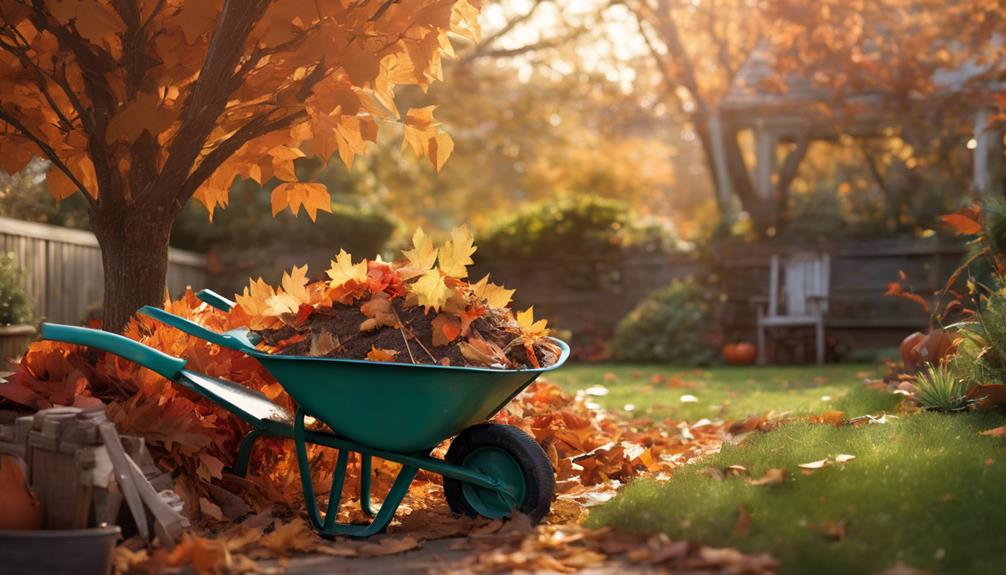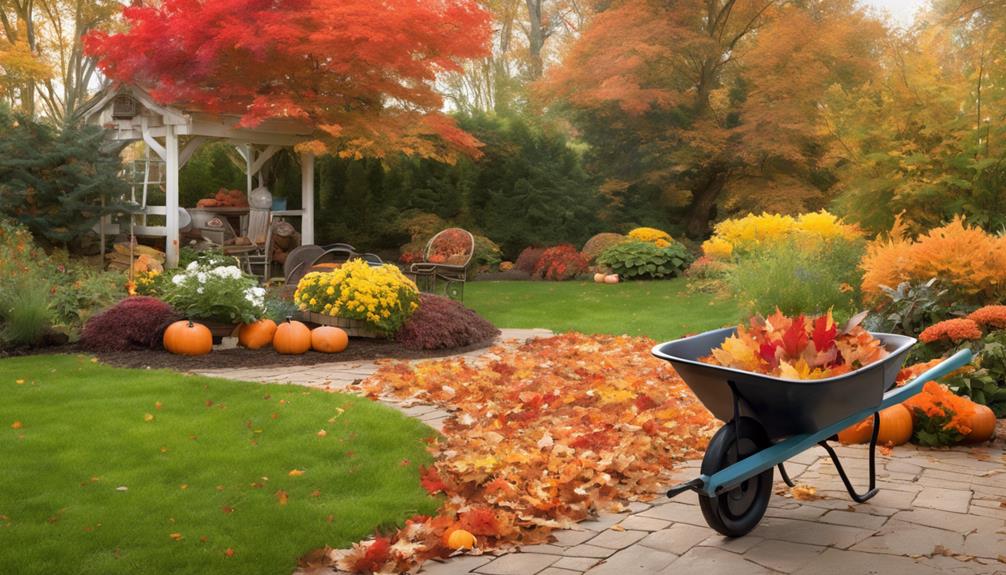
What Are Affordable Fall Garden Cleanup Tips?
30 January 2025
10 Best DIY Garden Maintenance Tips for Homeowners
30 January 2025Seasonal cleanup is essential for flower beds as it enhances plant health by removing debris that can harbour pests and diseases.
Regular removal of weeds reduces competition for vital nutrients and moisture, promoting stronger, healthier plants.
Furthermore, effective cleanup improves soil structure and aeration, ensuring optimal growth conditions for the forthcoming seasons.
By maintaining a tidy flower bed, gardeners encourage a balanced ecosystem that supports overall plant vitality.
Integrating proper seasonal cleanup practices can significantly impact your garden's success, offering insights into specific techniques and strategies that enhance flower blossom potential.
Seasonal Flower Bed Maintenance
Effective seasonal flower bed maintenance begins with the removal of debris and weeds, which can hinder plant growth and health.
Furthermore, enhancing soil health through practices such as mulching and composting is crucial for supporting vibrant blooms.
Removing Debris and Weeds
A pristine flower bed is a reflection of careful maintenance and attentiveness to detail, making the removal of debris and weeds a crucial step in seasonal cleanup.
Debris, such as fallen leaves and twigs, not only detracts from the aesthetic appeal but can also harbour pests and diseases that threaten plant health.
Weeds, competing for nutrients and moisture, can greatly hinder the growth of desired flora. Regularly inspecting the flower bed allows for the prompt identification and removal of these invasive plants, ensuring that cultivated species thrive.
Employing methods such as hand-pulling or using a hoe can be effective in controlling weed populations.
Ultimately, maintaining a debris-free flower bed fosters a healthier, more vibrant garden ecosystem.
Enhancing Soil Health
After clearing away debris and weeds, attention turns to improving soil health, which is fundamental for thriving flower beds. This process begins with soil testing, which provides insights into nutrient levels and pH balance.
Amendments such as compost, well-rotted manure, or organic fertilisers can then be applied to enrich the soil structure and nutrient profile. Moreover, incorporating cover crops during the off-season can prevent erosion and boost microbial activity, fostering a more resilient ecosystem.
Mulching serves a dual purpose, reducing moisture loss while suppressing weeds, further promoting soil health. Regularly aerating the soil encourages root penetration and nutrient absorption, ensuring that your flower beds are not only beautiful but also robust and sustainable throughout the growing season.
Soil Health and Nutrient Balance
Maintaining soil health and nutrient balance is crucial for the vitality of flower beds.
Effective pest control and prevention, alongside strategic weed management, can significantly improve soil quality by minimising competition for nutrients.
Furthermore, incorporating mulching techniques helps retain moisture, further supporting the comprehensive health of the soil ecosystem.
Pest Control and Prevention
Improving soil health and maintaining nutrient balance are vital components of effective pest control and prevention in flower beds.
Healthy soil fosters robust plants that are more resilient to pests, thereby reducing the necessity for chemical interventions.
Implementing the following strategies can significantly enhance your pest management efforts:
- Regular Soil Testing: Assess nutrient levels and pH to tailor amendments that support plant health.
- Incorporation of Organic Matter: Incorporate compost or well-rotted manure to enhance soil structure and microbial activity, which assists in pest resistance.
- Crop Rotation: Varying plant species from season to season disrupts pest life cycles, minimising infestations.
Weed Management Strategies
Effective pest control and prevention strategies naturally lead to reflections on weed management, as both share a common goal of promoting healthy flower beds.
Implementing robust weed management strategies is crucial for maintaining soil health and nutrient balance. Here are three key strategies to take into account:
- Cultural Practices: Encourage plant diversity and proper spacing to reduce weed competition. Healthy soil supports vigorous plant growth, which can outcompete weeds.
- Mechanical Control: Regularly remove weeds by hand or utilise tools such as hoes and cultivators. This practice minimises disturbance to the soil structure while effectively reducing weed populations.
- Cover Cropping: Planting cover crops during off-seasons can suppress weed growth while enriching the soil with organic matter, enhancing nutrient availability for subsequent flower beds.
Adopting these strategies will facilitate a thriving flower bed ecosystem.
Mulching for Moisture Retention
A thick layer of mulch acts as a protective blanket for flower beds, playing a crucial role in moisture retention and soil health. By minimising water evaporation, mulch ensures that plants receive adequate hydration, particularly during dry spells.
Additionally, it improves soil structure and promotes beneficial microbial activity, ultimately leading to enhanced nutrient availability.
Key benefits of mulching include:
- Temperature Regulation: Mulch insulates the soil, maintaining ideal temperatures for root development.
- Weed Suppression: A robust layer of mulch inhibits weed growth, reducing competition for moisture and nutrients.
- Erosion Prevention: Mulch helps to shield the soil from heavy rainfall, preventing erosion and nutrient loss.
Implementing mulching techniques is a crucial practice for any horticulturist aiming for vibrant, healthy flower beds.
Pruning Techniques for Flower Beds
Pruning is a vital aspect of maintaining healthy flower beds, as it helps assess the condition of plants and promotes optimal growth.
Timing plays an essential role in pruning, ensuring that plants are prepared for seasonal changes and new planting opportunities.
Furthermore, understanding soil amendments can enhance the benefits of pruning, leading to vibrant and flourishing flower beds.
Assess Flower Bed Conditions
Evaluating the condition of flower beds is essential for maintaining their health and aesthetic appeal. A thorough assessment allows gardeners to identify issues that could hinder growth and flowering.
Here are three key aspects to consider during your evaluation:
- Soil Quality: Check for compaction, drainage, and nutrient levels to ensure ideal root development.
- Plant Health: Inspect plants for signs of pests, diseases, or nutrient deficiencies, which can affect overall vigour.
- Layout and Spacing: Assess whether plants are overcrowded or misaligned, which can impact sunlight exposure and air circulation.
Timing for Optimal Planting
Understanding the current condition of flower beds not only informs maintenance practices but also sets the stage for successful planting.
Pruning techniques, when timed correctly, can greatly enhance the health and aesthetic appeal of your flower beds. Ideal planting timing is crucial for ensuring robust growth and flowering.
Consider these key factors for effective pruning:
- Seasonal Timing: Prune during dormancy in late winter or early spring to encourage new growth.
- Plant Type: Different species have specific pruning windows; research your plants to determine the best time.
- Weather Conditions: Avoid pruning during wet or excessively hot periods to prevent stress and disease.
Employing these strategies will ensure a flourishing flower bed, ready for the forthcoming growing season.
Soil Amendments for Flower Beds
A well-prepared flower bed begins with the right soil amendments, which play a pivotal role in promoting healthy plant growth and vibrant blooms.
The incorporation of specific amendments improves soil structure, fertility, and moisture retention, ultimately leading to more robust flowering plants.
Key soil amendments to consider include:
- Organic Matter: Incorporating well-rotted compost or matured manure enhances soil structure and provides essential nutrients.
- Mulch: Applying organic mulch not only regulates soil temperature but also suppresses weeds and retains moisture.
- pH Adjusters: Adding lime or sulphur can help achieve the ideal pH level for particular flowering species, ensuring nutrient availability.
Enhanced Flower Growth Potential
How can gardeners optimise the potential for vibrant blooms in their flower beds? Seasonal clean-up plays a crucial role in enhancing flower growth by removing debris, weeds, and spent blooms that can hinder the health of plants. This process not only fosters a cleaner environment but also promotes air circulation, thereby reducing the risk of disease.
| Benefit | Impact on Flower Growth |
|---|---|
| Improved Soil Quality | Healthier roots, stronger plants |
| Improved Nutrient Availability | More robust blooms, vibrant colours |
| Pest and Disease Management | Increased longevity and liveliness |
Garden Design and Planning
Effective garden design and planning require careful consideration of fertiliser application timing and methods to optimise plant growth.
Understanding the benefits of natural fertiliser options can further enhance the health and vitality of your flower beds.
Fertilizer Application Timing
Timing is crucial when applying fertiliser to flower beds, as it directly impacts plant health and blooming potential.
Understanding the ideal timing can enhance nutrient absorption and promote vigorous growth. Consider the following key points for effective fertiliser application:
- Early Spring: Apply a balanced fertiliser when plants begin to emerge. This encourages robust growth during the active growing season.
- Blooming Phase: During the flowering period, a fertiliser high in phosphorus can stimulate blooming and improve flower quality.
- Late Summer: A final application of slow-release fertiliser can help prepare plants for winter dormancy, ensuring they have adequate nutrients stored.
Fertilizer Application Methods
When planning a garden, selecting the appropriate fertiliser application method is essential for maximising plant health and ensuring ideal growth.
Different techniques can enhance nutrient uptake and minimise waste. Here are three effective methods:
- Broadcasting: Evenly distributing granular fertilisers over the soil surface guarantees a wide coverage area, promoting uniform nutrient availability.
- Banding: Applying fertiliser in narrow bands near the root zone allows for targeted nutrient delivery, improving absorption while reducing competition from weeds.
- Foliar Feeding: Spraying liquid fertilisers directly onto plant leaves provides immediate access to nutrients, particularly beneficial during critical growth stages.
Natural Fertilizer Options
Natural fertilisers offer an eco-friendly alternative to synthetic options, enriching the soil while promoting sustainable gardening practices.
Utilising natural fertilisers not only nourishes plants but also improves soil structure and microbial health.
Here are three effective options for your flower beds:
- Compost: Rich in nutrients and beneficial microorganisms, compost enhances soil fertility and water retention, creating a thriving ecosystem for your plants.
- Manure: Well-aged manure from herbivorous animals provides a balanced nutrient profile, boosting soil organic matter and promoting plant growth when applied correctly.
- Bone Meal: A slow-release source of phosphorus and calcium, bone meal supports root development and flowering, making it ideal for blooming plants.
Incorporating these natural fertilisers can lead to healthier, more vibrant flower beds, aligning with sustainable gardening principles.
Pest Infestation Remedies
Effective pest management is essential for maintaining healthy flower beds.
This discussion will explore various organic pest deterrent options, techniques for managing fungal diseases, and the advantages of companion planting.
Organic Pest Deterrent Options
To maintain vibrant flower beds and protect them from pests, organic pest deterrent options provide a sustainable solution for gardeners.
Utilising these natural remedies not only safeguards your plants but also promotes ecological balance.
Here are three effective organic pest deterrents:
- Neem Oil: Derived from the seeds of the neem tree, this oil disrupts the life cycle of pests, effectively repelling them without harming beneficial insects.
- Diatomaceous Earth: This natural powder, composed of fossilised algae, works by dehydrating insects upon contact, making it a formidable barrier against pests.
- Garlic Spray: A simple mixture of garlic and water serves as a potent repellent, deterring a variety of insects with its strong odour.
Incorporating these options into your gardening routine can lead to healthier flower beds.
Fungal Disease Management Techniques
Fungal diseases can pose a significant threat to the health and beauty of flower beds, often leading to diminished plant vigour and unsightly appearances.
Effective management techniques are crucial for maintaining robust floral displays.
Consider implementing the following strategies:
- Sanitation Practices: Regularly remove dead leaves and debris, as these can harbour fungal spores and promote disease spread.
- Proper Watering Techniques: Water plants at the base rather than overhead to minimise leaf wetness, which can encourage fungal growth.
- Fungicide Application: Utilise appropriate fungicides when necessary, following label instructions carefully to ensure effective treatment without harming beneficial organisms.
Companion Planting Benefits
The synergy created through companion planting offers a powerful remedy for pest infestations in flower beds.
By strategically pairing plants, gardeners can enhance their flower beds' resilience against harmful pests. This method not only fosters a balanced ecosystem but also minimises the need for chemical interventions.
Consider these companion planting benefits:
- Natural Pest Deterrence: Certain plants, such as marigolds, emit compounds that repel aphids and nematodes, protecting neighbouring flowers.
- Attraction of Beneficial Insects: Flowering herbs like dill and fennel attract predators such as ladybirds and lacewings, which feed on pest populations.
- Soil Health Improvement: Diverse root structures enhance nutrient uptake and soil aeration, supporting plant vigour and reducing vulnerability to infestations.
Implementing these strategies will cultivate a more resilient flower bed.
Why Choose TKL Birmingham Gardener
Choosing TKL Birmingham Gardener for your seasonal cleanup needs ensures that your flower beds receive the expert care they deserve.
Our team is well-versed in horticultural principles, ensuring that each flower bed is meticulously assessed and attended to with precision. We employ advanced techniques to improve soil health, promote biodiversity, and enhance plant performance.
Our commitment to sustainable practices means we utilise environmentally friendly methods that respect the ecosystem. With a wealth of experience, TKL Birmingham Gardener is adept at identifying the unique needs of your garden, tailoring our services to amplify aesthetic appeal and health.
Trusting us with your seasonal cleanup not only enhances the beauty of your flower beds but also fosters long-term growth and resilience.
Choose mastery; choose TKL Birmingham Gardener.
Common Seasonal Cleanup Questions
As the seasons change, many homeowners find themselves with a myriad of questions regarding the best practices for seasonal cleanup in their flower beds.
Common inquiries often include: When is the ideal time to perform a cleanup? The answer typically lies in the local climate and specific plant needs, with spring and autumn being the most critical periods.
Another frequent question is how to effectively remove dead plants and debris without disturbing healthy root systems. It is crucial to use appropriate tools and techniques to minimise disruption.
Moreover, homeowners often wonder about the best methods for amending soil post-cleanup. Incorporating organic matter and ensuring proper pH levels can improve soil health, fostering vibrant flower beds for the upcoming season.
Finalizing Your Cleanup Checklist
Homeowners often find it beneficial to have a comprehensive cleanup checklist to ensure nothing is overlooked during the seasonal change of their flower beds.
A well-structured checklist not only guarantees thoroughness but also enhances the efficiency of the cleanup process.
Consider incorporating the following essential items into your final checklist:
- Remove Debris: Clear away fallen leaves, dead plants, and weeds to prevent pest infestations and promote healthy growth.
- Soil Assessment: Test the soil's pH and nutrient levels, and amend it accordingly to optimise plant health.
- Mulching: Apply a fresh layer of mulch to retain moisture, suppress weeds, and regulate soil temperature.




